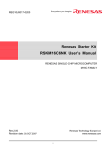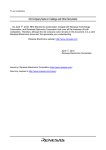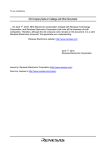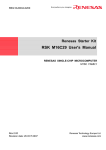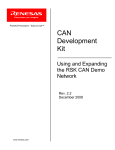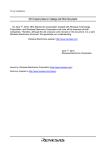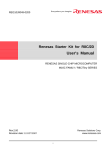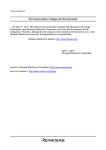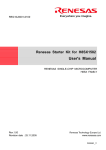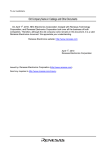Download Renesas M16C/6NK User`s manual
Transcript
REG10J0017-0100 Renesas Starter Kit RSKM16C6NK User’s Manual RENESAS SINGLE-CHIP MICROCOMPUTER M16C FAMILY Rev.01.00 Revision date:28.06.2006 Renesas Technology Europe Ltd. www.renesas.com i Table of Contents Chapter 1. Preface ..................................................................................................................................................1 Chapter 2. Purpose .................................................................................................................................................2 Chapter 3. Power Supply ........................................................................................................................................3 3.1. Requirements ...............................................................................................................................................3 3.2. Power – Up Behaviour .................................................................................................................................3 Chapter 4. Board Layout .........................................................................................................................................4 4.1. Component Layout .......................................................................................................................................4 4.2. Board Dimensions ........................................................................................................................................5 Chapter 5. Block Diagram .......................................................................................................................................6 Chapter 6. User Circuitry.........................................................................................................................................7 6.1. Switches .......................................................................................................................................................7 6.2. LEDs.............................................................................................................................................................7 6.3. Potentiometer ...............................................................................................................................................7 6.4. Serial port .....................................................................................................................................................8 6.5. LCD Module..................................................................................................................................................9 6.6. Option Links................................................................................................................................................10 6.7. Oscillator Sources ......................................................................................................................................14 6.8. Reset Circuit ...............................................................................................................................................14 Chapter 7. Modes..................................................................................................................................................15 7.1. Boot mode...............................................................................................................................................15 7.2. Single chip mode ....................................................................................................................................15 Chapter 8. Programming Methods........................................................................................................................16 Chapter 9. Headers...............................................................................................................................................17 9.1. Microcontroller Headers .............................................................................................................................17 9.2. Application Headers ...................................................................................................................................19 Chapter 10. Code Development ...........................................................................................................................23 10.1. Overview...................................................................................................................................................23 10.2. Mode Support ...........................................................................................................................................23 10.3. Breakpoint Support...................................................................................................................................23 10.4. Memory Map.............................................................................................................................................24 Chapter 11. Component Placement......................................................................................................................25 Chapter 12. Additional Information........................................................................................................................26 ii Chapter 1. Preface Cautions This document may be, wholly or partially, subject to change without notice. All rights reserved. Duplication of this document, either in whole or part is prohibited without the written permission of Renesas Technology Europe Limited. Trademarks All brand or product names used in this manual are trademarks or registered trademarks of their respective companies or organisations. Copyright © Renesas Technology Europe Ltd. 2006. All rights reserved. © Renesas Solutions Corporation. 2006. All rights reserved. © Renesas Technology Corporation. 2006. All rights reserved. Website: http://www.eu.renesas.com/ Glossary CPU Central Processing Unit RTE Renesas Technology Europe Ltd. HEW High-performance Embedded Workshop RSO Renesas Solutions Organisation. LED Light Emitting Diode RSK Renesas Starter Kit PC Program Counter 1 Chapter 2. Purpose This RSK is an evaluation tool for Renesas microcontrollers. Features include: • Renesas Microcontroller Programming. • User Code Debugging. • User Circuitry such as Switches, LEDs and potentiometer(s). • User or Example Application. • Sample peripheral device initialisation code. The RSK board contains all the circuitry required for microcontroller operation. 2 Chapter 3. Power Supply 3.1. Requirements This RSK operates from a 5V power supply. A diode provides reverse polarity protection only if a current limiting power supply is used. All RSK boards are supplied with an E8 debugger. This product is able to power the RSK board with up to 300mA. When the RSK is connected to another system then that system should supply power to the RSK. All RSK boards have an optional centre positive supply connector using a 2.1mm barrel power jack. Warning The RSK is neither under nor over voltage protected. Use a centre positive supply for this board. 3.2. Power – Up Behaviour When the RSK is purchased the RSK board has the ‘Release’ or stand alone code from the example tutorial code pre-programmed into the Renesas microcontroller. On powering up the board the user LEDs will start to flash. After 200 flashes, or after pressing a switch the LEDs will flash at a rate controlled by the potentiometer. 3 Chapter 4. Board Layout 4.1. Component Layout The following diagram shows the top layer component layout of the board. Figure 4-1: Board Layout 4 4.2. Board Dimensions The following diagram gives the board dimensions and connector positions. All through hole connectors are on a common 0.1” grid for easy interfacing. 120.00mm 115.00mm 86.36mm Short Board = 85 mm Corners x4 3mm radius 50.80 mm 43.18 mm 35.56 mm 27.00mm SW 1 SW 2 SW 3 POT JA2 Other JA6 J1 - Applies to connector J4 R E S 14.00mm Serial D9 SKT JA4 J3 JA5 JA1 3.81mm 5.00mm 45.00mm Figure 4-2 : Board Dimensions 5 100.00mm MCU 85.00mm J2 RING Application Header (LCD) Application Header (Expansion Bus) E8 JA3 80.01mm with micriocontroller pin1 Chapter 5. Block Diagram Figure 5-1 is representative of the CPU board components and their connectivity. Power Jack Option LCD Application Board Headers Boot mode pins Boot Circuitry Microcontroller Microcontroller Pin Headers RESET pin RESn D-type latch BOOT & BOOTn signals Debug Header Option ADC Input IRQ pin IRQ pin IRQ pin Serial Connector Option SW2 SW3 Potentiometer RES BOOT SWITCHES LEDs User: 4 LEDS 1Green, 1Orange, 2Red Power: Green Boot: Orange Figure 5-1: Block Diagram Figure 5-2 is representative of the connections required to the RSK. S W 1 S W 2 S W 3 POT JA2 Other JA6 J1 - Applies to connector Optional Expansion Bus connector with micriocontroller pin1 E8 J2 MCU J4 Computer Serial D9 SKT Figure 5-2 : RSK Connections 6 JA3 J3 R E S JA1 JA5 Chapter 6. User Circuitry 6.1. Switches There are four switches located on the RSK. The function of each switch and its connection are shown in Table 6-1. Switch Function Microcontroller RES When pressed the RSK microcontroller is reset. RESn SW1/BOOT* Connects to an IRQ input for user controls. INT0 Pin18 The switch is also used in conjunction with the RES switch to place (Port 8, pin 2) the device in BOOT mode when not using the E8 debugger. SW2* Connects to an IRQ line for user controls. INT1 Pin17 (Port 8, pin 3) SW3* Connects to the ADC trigger input. Option link allows connection to ADTRG Pin 98 IRQ line. The option is a pair of 0R links. (Port 9, pin 7) OR INT2 Pin16 (Port 8, pin 4) Table 6-1: Switch Functions *Refer to schematic for detailed connectivity information. 6.2. LEDs There are six LEDs on the RSK board. The green ‘POWER’ LED lights when the board is powered. The orange BOOT LED indicates the device is in BOOT mode when lit. The four user LEDs are connected to an IO port and will light when their corresponding port pin is set low. Table 6-2, below, shows the LED pin references and their corresponding microcontroller port pin connections. LED Reference (As shown Microcontroller Port Pin function Microcontroller Pin Number on silkscreen) LED0 Port 4.0 52 LED1 Port 4.1 51 LED2 Port 4.2 50 LED3 Port 4.3 49 Table 6-2: LED Port 6.3. Potentiometer A single turn potentiometer is connected to AN0.0 (P10.0) of the microcontroller. This may be used to vary the input analogue voltage value to this pin between AVCC and Ground. 7 6.4. Serial port The microcontroller programming serial port 1 is connected to the E8 connector. A serial port can be used by moving option resistors and fitting the D connector. This can be connected to serial channel 1 if the E8 is disabled from using channel 1; or serial channel 0 while the E8 is enabled. Description TxD1 Function Programming Fit For E8 Remove for Fit for Remove for Fit for Remove for E8 RS232 RS232 RS232 RS232 Channel 0 Channel 0 Channel 1 Channel 1 R13 R68 R69 R68 R68 R69, R13 R12 R44 R47 R44 R44 R47, R12 R14 NA NA NA NA R14 Serial Port RxD1 Programming Serial Port CLK1 Programming Serial Port Table 6-3: Serial port connections If a serial port is used the D-connector U3 must be fitted and the RS232 transceiver enabled. Description Function RS232 Disables/Enables Transceiver U3 RS232 Enable Transceiver Fit For Remove for Fit For Remove for RS233 RS233 RS233 RS233 Enable Enable Disable Disable R42 R39 R39 Table 6-4: RS232 enable An additional serial port is connected to the application headers. 8 R42 6.5. LCD Module An LCD module is supplied to be connected to the connector J11. This should be fitted so that the LCD module lies over J3. Care should be taken to ensure the pins are inserted correctly into J11.The LCD module uses a 4 bit interface to reduce the pin allocation. No contrast control is provided; this is set by a resistor on the supplied display module. The module supplied with the RSK only supports 5V operation. Table 6-5 shows the pin allocation and signal names used on this connector. J11 Pin Circuit Net Name Device Pin Circuit Net Name Device Pin Pin 1 Ground - 2 5V Only - 3 No Connection - 4 DLCDRS 70 5 R/W (Wired to Write only) - 6 DLCDE 69 7 No Connection - 8 No Connection - 9 No Connection - 10 No Connection - 11 DLCD4 66 12 DLCD5 65 13 DLCD6 64 14 DLCD7 63 Table 6-5 LCD Module Connections 9 6.6. Option Links Table 6-6 below describes the function of the option links contained on this RSK board. Option Link Settings Reference R14 Function Fitted Alternative (Removed) Related To Connects SCK to E8 SCK disconnected from E8 Programming Connects E8 to Programming MUST be removed if R44 fitted. R44 Serial Port Serial port. Programming Connects E8 to Programming Should be removed if R68 fitted. R68 Serial Port Serial port. Programming Connects RS232 port to MUST be removed if R12, R47 R12, R47, R49 Serial Port Programming SCI port or R49 fitted. Programming Connects RS232 port to MUST be removed if R13, R69 Serial Port Programming SCI port or R72 fitted. RS232 Driver Enables RS232 Serial MUST be removed if R39 Transceiver Fitted Disables RS232 Serial MUST be removed if R42 Fitted R42 Connects Alternate serial (CH2) Disconnects Alternate serial R40 to D connector from D connector. Connects Alternate serial (CH2) Disconnects Alternate serial to D connector from D connector. Connects Alternate Serial (CH2 Should be removed if SCIb - SCIb) to RS232 Transceiver not used for RS232. Connects Alternate Serial (CH2 Should be removed if SCIb - SCIb) to RS232 Transceiver not used for RS232. RS232 Serial on Connects Application Header to MUST be removed if R68 or Application Header RS232 Transceiver R69 fitted. RS232 Serial on Connects Application Header to MUST be removed if R44 or Application Header RS232 Transceiver R47 fitted. RS232 Serial on Connects Serial Channel 0 to MUST be removed if R68 or SCIa CH0 RS232 Transceiver R72 fitted. RS232 Serial on Connects Serial Channel 0 to MUST be removed if R44 or SCIa CH0 RS232 Transceiver R49 fitted. External Oscillator Connects External Ring header Disconnects sensitive pins to Microcontroller microcontroller signals from Programming Serial Port R12 R13 R44 R68 R42 R39 RS232 Driver R13, R69, R72 R39 Transceiver R41 R40 R55 R50 R72 R49 R69 R47 R96 Serial Connector Serial Connector Alternate Serial Alternate Serial external pins. 10 R41 R50 R55 R68, R69 R44, R47 R68, R72 R44, R49 R100 Option Link Settings Reference R100 Function Fitted Alternative (Removed) External Oscillator Connects External Ring header Disconnects sensitive pins to Microcontroller microcontroller signals from Related To R96 external pins. R97 External Oscillator Parallel resistor for crystal Not fitted R103 External Subclock Connects External Ring header Disconnects sensitive Oscillator pins to Microcontroller microcontroller signals from R105 external pins. R105 External Subclock Connects External Ring header Disconnects sensitive Oscillator pins to Microcontroller microcontroller signals from R103 external pins. R106 External Subclock Parallel resistor for crystal Not fitted Supply to board from J5 Fit Low ohm resistor to measure Oscillator R9 Board VCC current R32 R33 R25 Microcontroller Supply to microcontroller Fit Low ohm resistor to measure VCC1 VCC1 current Microcontroller Supply to microcontroller Fit Low ohm resistor to measure VCC2 VCC2 current Board VCC1 Board VCC1 connected to Disconnected R23,28 Disconnected R23,R25 Disconnected R25,R28 Disconnected R24,29 Disconnected R24,R26 Disconnected R26,R29 Connects Board VCC1 Analogue supply MUST be JA1,R43 supply to Analogue supply provided from external interface R33 R32 Connector 3V3 R28 Board VCC1 Board VCC1 connected to Connector 5V R23 Board VCC1 Board VCC1 connected to Connector J5 R26 Board VCC2 Board VCC2 connected to Connector 3V3 R29 Board VCC2 Board VCC2 connected to Connector 5V R24 Board VCC2 Board VCC2 connected to Connector J5 R31 Analogue Power pins. (Fit R43) R43 Analogue Power Connects AVCC supply to Application headers 11 R31 must be fitted R31 Option Link Settings Reference R109 Function VREF Fitted Alternative (Removed) Connects Board VCC1 VREF can be provided from supply to VREF external interface pins. (Fit Related To JA1,R110 R110) R110 VREF VREF to Application headers R109 should be fitted R109 R35 SW3 Connects SW3 to Analogue Disconnected R34 Trigger input R34 SW3 Connects SW3 to INT2 input Disconnected R35 R82 Microcontroller pin Connects microcontroller pin MUST be removed if R80 fitted. R80 function select 28 to IICSDA Microcontroller pin Connects microcontroller pin 28 Should be removed if R82 R82 function select to TXD2 pin fitted. Microcontroller pin Connects microcontroller pin MUST be removed if R80 fitted. R76 function select 27 to IICSCL Microcontroller pin Connects microcontroller pin 27 Should be removed if R78 R78 function select to RXD2 fitted. Microcontroller pin Connects microcontroller pin MUST be removed if R115 function select 95 to ADPOT fitted. Microcontroller pin Connects microcontroller pin 95 Should be removed if R114 function select to AN0 fitted. Microcontroller pin Connects microcontroller pin 44 MUST be removed if R61 function select to Wrn pin fitted. Microcontroller pin Connects microcontroller pin Should be removed if R60 function select 44 to WRLn pin fitted. Microcontroller pin Connects microcontroller pin 20 MUST be removed if R93 function select to TA4OUT pin fitted. Microcontroller pin Connects microcontroller pin Should be removed if R94 function select 20 to Up pin fitted. Microcontroller pin Connects microcontroller pin 19 MUST be removed if R92 function select to TA4IN pin fitted. Microcontroller pin Connects microcontroller pin Should be removed if R92 function select 19 to Un pin fitted. Microcontroller pin Connects microcontroller pin 26 MUST be removed if R83 function select to CLK2 pin fitted. Microcontroller pin Connects microcontroller pin Should be removed if R84 function select 26 to Vp pin fitted. Microcontroller pin Connects microcontroller pin 24 MUST be removed if R85 function select to TA2OUT pin fitted. R80 R78 R76 R114 R115 R60 R61 R94 R93 R92 R90 R84 R83 R87 12 R115 R114 R61 R60 R93 R94 R90 R92 R90 R92 R87 Option Link Settings Reference R85 R88 R86 R128 R130 R118 R116 R131 R129 R117 R119 R67 R66 R45 R46 Function Fitted Alternative (Removed) Microcontroller pin Connects microcontroller pin Should be removed if R87 function select 24 to Wp pin fitted. Microcontroller pin Connects microcontroller pin 23 MUST be removed if R86 function select to TA2IN pin fitted. Microcontroller pin Connects microcontroller pin Should be removed if R88 function select 23 to Wn pin fitted. Microcontroller pin Connects microcontroller pin 47 MUST be removed if R130 function select to A21 pin fitted. Microcontroller pin Connects microcontroller pin Should be removed if R128 function select 47 to CS2N pin fitted. Microcontroller pin Connects microcontroller pin 46 MUST be removed if R116 function select to A22 pin fitted. Microcontroller pin Connects microcontroller pin Should be removed if R118 function select 46 to CS1N pin fitted. Microcontroller pin Connects microcontroller pin 90 MUST be removed if R129 function select to AN4 pin fitted. Microcontroller pin Connects microcontroller pin Should be removed if R131 function select 90 to CAN0 EN pin fitted. Microcontroller pin Connects microcontroller pin 89 MUST be removed if R117 function select to AN5 pin fitted. Microcontroller pin Connects microcontroller pin Should be removed if R119 function select 89 to CAN0 STBn pin fitted. Microcontroller pin Connects microcontroller pin 88 MUST be removed if R66 function select to AN6 pin fitted. Microcontroller pin Connects microcontroller pin Should be removed if R67 function select 88 to CAN1 EN pin Microcontroller pin Connects microcontroller pin 87 MUST be removed if R46 function select to AN7 pin fitted. Microcontroller pin Connects microcontroller pin Should be removed if R45 function select 87 to CAN1 STBn pin fitted. Related To R85 R86 R88 R130 R128 R116 R118 R129 R131 R119 R117 R66 R67 fitted. Table 6-6 Option Links 13 R46 R45 6.7. Oscillator Sources A crystal oscillator is fitted on the RSK and used to supply the main clock input to the Renesas microcontroller. Table 6-7 details the oscillators that are fitted and alternative footprints provided on this RSK: Component Crystal (X1) Fitted 10MHz (HC/49U package) Subclock (X2) Fitted 32.768kHz (90SMX package) Table 6-7: Oscillators / Resonators 6.8. Reset Circuit The CPU Board includes a simple latch circuit that links the mode selection and reset circuit. This provides an easy method for swapping the device between Boot Mode, User Boot Mode and User mode. This circuit is not required on customers boards as it is intended for providing easy evaluation of the operating modes of the device on the RSK. Please refer to the hardware manual for more information on the requirements of the reset circuit. The Reset circuit operates by latching the state of the boot switch on pressing the reset button. This control is subsequently used to modify the mode pin states as required. The mode pins should change state only while the reset signal is active to avoid possible device damage. The reset is held in the active state for a fixed period by a pair of resistors and a capacitor. Please check the reset requirements carefully to ensure the reset circuit on the user’s board meets all the reset timing requirements. 14 Chapter 7. Modes The RSK supports Boot mode and Single chip mode. Details of programming the FLASH memory is described in the M16C/6NK Group Hardware Manual. 7.1. Boot mode The boot mode settings for this RSK are shown in Table 7-1: Boot Mode pin settings below: CNVSS P5.0 P5.5 LSI State after Reset End 1 1 0 Boot Mode Table 7-1: Boot Mode pin settings The software supplied with this RSK only supports Boot mode using an E8 and HEW. However, hardware exists to enter boot mode manually, do not connect the E8 in this case. Press and hold the SW1/BOOT. The mode pins above are held in their boot states while reset is pressed and released. Release the boot button. The BOOT LED will be illuminated to indicate that the microcontroller is in boot mode. When neither the E8 is connected nor the board is placed in boot mode (with CNVSS and P5.5 being pulled low during reset) as above, the P5.5 pin is pulled high by a 10k resistor, the P.5.0 pin is pulled high by a 100k resistor and the CNVSS is pulled low by a 100k resistor. When an E8 is used these three pins are controlled by the E8. 7.2. Single chip mode This RSK is configured to always boot in Single Chip mode when the E8 is not connected and the boot switch is not depressed as CNVSS is pulled down by a 100k resistor. Refer to M16C/6NK Group Hardware Manual for details of Single chip mode. CNVSS P5.0 P5.5 LSI State after Reset End 0 1 1 Single Chip Mode Table 7-2: Single Chip Mode pin settings 15 Chapter 8. Programming Methods The board is intended for use with HEW and the supplied E8 debugger. Refer to the M16C/6NK Group Hardware Manual for details of programming the microcontroller without using these tools. 16 Chapter 9. Headers 9.1. Microcontroller Headers Table 9-1 to Table 9-4 show the microcontroller pin headers and their corresponding microcontroller connections. The header pins connect directly to the microcontroller pins. * Marked pins are subject to option links. J1 Pin Circuit Net Name Device Pin Circuit Net Name Device Pin Pin 1 CAN1OUT 99 2 CAN1IN 100 3 DA1 1 4 DA0 2 5 TXD2 3 6 RXD2 4 7 CLK3 5 8 BYTE 6 9 E8_CNVSS 7 10 CON_XCIN 8 11 CON_XCOUT 9 12 RESn 10 13 CON_XOUT 11 14 GROUND 12 15 CON_XIN 13 16 UC_VCC1 14 17 NMIn 15 18 INT2 16 19 INT1 17 20 INT0 18 21 TA4IN_Un* 19 22 TA4OUT_Up* 20 23 CAN0IN 21 24 CAN0OUT 22 25 TA2IN_Wn 23 26 TA2OUT_Wp* 24 27 Vn 25 28 CLK2_Vp* 26 29 IIC_SCL_RXD2* 27 30 IICSDA_TXD2* 28 Table 9-1: J1 J2 Pin Circuit Net Name Device Pin Circuit Net Name Pin Device Pin 1 PTTX 29 2 PTRX 30 3 PTCK 31 4 E8_BUSY 32 5 TXD0 33 6 RXD0 34 7 CLK0 35 8 CTSRTS 36 9 RDY 37 10 ALE 38 11 E8_EPM 39 12 UD 40 13 TRSTn 41 14 RDn 42 15 WRHn 43 16 WRLn_WRn 44 17 A23n_CS0n 45 18 A22_CS1n 46 19 A21_CS2n 47 20 A20_CS3n 48 Table 9-2: J2 17 J3 Pin Circuit Net Name Device Pin Circuit Net Name Pin Device Pin 1 A19_LED3 49 2 A18_LED2 50 3 A17_LED1 51 2 A16_LED0 52 5 A15_IO7 53 6 A14_IO6 54 7 A13_IO5 55 8 A12_IO4 56 9 A11_IO3 57 10 A10_IO2 58 11 A9_IO1 59 12 UC_VCC2 60 13 A8_IO0 61 14 GROUND 62 15 A7_DLCD7 63 16 A6_DLCD6 64 17 A5_DLCD5 65 18 A4_DLCD4 66 19 A3 67 20 A2 68 21 A1_DLCDE 69 22 A0_DLCDRS 70 23 D15 71 24 D14 72 25 D13 73 26 D12 74 27 D11 75 28 D10 76 29 D9 77 30 D8 78 Table 9-3: J3 J4 Pin Circuit Net Name Device Pin Circuit Net Name Pin Device Pin 1 D7 79 2 D6 80 3 D5 81 4 D4 82 5 D3 83 6 D2 84 7 D1 85 8 D0 86 9 AN7_CAN1STBn 87 10 AN6_CAN1EN 88 11 AN5_CAN0STBn 89 12 AN4_CAN0EN 90 13 AN3 91 14 AN2 92 15 AN1 94 16 AVss 94 17 ADPOT_AN0 96 18 CON_AVREF 96 19 CON_AVCC 97 20 ADTRG 99 Table 9-4: J4 18 9.2. Application Headers Table 9-5 and Table 9-6 below show the standard application connections. * Marked pins are subject to option links. JA1 Pin Generic Header Name RSK Signal Device Name Pin Pin Header Name RSK Signal Device Name Pin 1 Regulated Supply 1 5V 2 Regulated Supply 1 GROUND 3 Regulated Supply 2 3V3 4 Regulated Supply 2 GROUND 5 Analogue Supply AVcc 97 6 Analogue Supply AVss 94 7 Analogue Reference AVref 96 8 ADTRG ADTRG 98 9 ADC0 I0 ADPot_AN0* 95 10 ADC1 I1 AN1 93 11 ADC2 I2 AN2 92 12 ADC3 I3 AN3 91 13 DAC0 DA0 2 14 DAC1 DA1 1 15 IOPort A8_IO_0 61 16 IOPort A9_IO_1 59 17 IOPort A10_IO_2 59 18 IOPort A11_IO_3 64 19 IOPort A12_IO_4 63 20 IOPort A13_IO_5 62 21 IOPort A14_IO_6 61 22 IOPort A15_IO_7 60 23 Interrupt D13_INT3 73 24 I²C Bus - (3rd pin) NC - 25 I²C Bus IIC_SDA* 28 26 I²C Bus IIC_SCL* 27 IRQAEC Table 9-5: JA1 Standard Generic Header JA2 Pin Header Name RSK Signal Device Name Pin Pin Header Name RSK Signal Device Name Pin 1 Reset RESn 10 2 External Clock Input EXTAL 3 Interrupt NMIn 15 4 Regulated Supply 1 Vss1 5 SPARE - - 6 Serial Port TxD0 33 7 Interrupt INT0 18 8 Serial Port RxD0 34 9 Interrupt INT1 17 10 Serial Port CLK0 35 11 Motor control UD 40 12 Serial Port Handshake CTSRTS 36 13 Motor control Up* 20 14 Motor control Un* 19 15 Output Vp* 26 16 Motor control Vn 25 17 Input Wp* 24 18 Motor control Wn* 23 19 Output TA2OUT* 23 20 Output TA4OUT 20 21 Input TA2IN* 20 22 Input TA4IN 19 23 Open drain INT2 16 24 Tristate Control TRSTn 41 25 SPARE - 26 SPARE - Table 9-6: JA2 Standard Generic Header 19 - Table 9-7 to Table 9-9 below show the optional generic header connections. * Marked pins are subject to option links. JA3 Pin Header Name RSK Signal Device Name Pin Pin Header Name RSK Signal Device Name Pin 1 A0 A0 70 2 A1 A1 69 3 A2 A2 68 4 A3 A3 67 5 A4 A4 66 6 A5 A5 65 7 A6 A6 64 8 A7 A7 63 9 A8 A8 61 10 A9 A9 59 11 A10 A10 58 12 A11 A11 57 13 A12 A12 56 14 A13 A13 55 15 A14 A14 54 16 A15 A15 53 17 D0 D0 86 18 D1 D1 85 19 D2 D2 84 20 D3 D3 83 21 D4 D4 82 22 D5 D5 81 23 D6 D6 80 24 D7 D7 79 25 RDn RDn 42 26 WRn WRn 44 27 CSan A23_CS0n 45 28 CSbn CS1n 46 29 D8 D8 78 30 D9 D9 77 31 D10 D10 76 32 D11 D11 75 33 D12 D12 74 34 D13 D13 73 35 D14 D14 72 36 D15 D15 71 37 A16 A16 52 38 A15 A15 51 39 A18 A18 50 40 A19 A19 49 41 A20 A20 48 42 A21 A21 47 43 A22 A22 46 44 SDCLK --- --- 45 CScn CS2n 47 46 ALE ALE 38 47 HWRn WRHn 43 48 LWRn WRLn 44 49 CASn --- --- 50 RASn --- --- Table 9-7: JA3 Optional Generic Header 20 JA5 Pin Header Name RSK Signal Device Name Pin Pin Header Name RSK Signal Device Name Pin 1 ADC4 I4 AN4* 90 2 ADC5 I5 AN5* 89 3 ADC6 I6 AN6* 88 4 ADC7 I7 AN7* 97 5 CAN CAN0OUT 22 6 CAN CAN0IN 21 7 CAN CAN1OUT 99 8 CAN CAN1IN 100 9 Reserved 10 Reserved 11 Reserved 12 Reserved 13 Reserved 14 Reserved 15 Reserved 16 Reserved 17 Reserved 18 Reserved 19 Reserved 20 Reserved 21 Reserved 22 Reserved 23 Reserved 24 Reserved Table 9-8: JA5 Optional Generic Header. JA6 Pin Header Name RSK Signal Device Name Pin Pin Header Name RSK Signal Device Name Pin 1 DMA --- --- 2 DMA DACK -- 3 DMA --- --- 4 Standby (Open drain) STBYn --- 5 Host Serial RS232TX --- 6 Host Serial RS232RX --- 7 Serial Port RXD2* 27 8 Serial Port TxD2* 28 9 Serial Port Synchronous TXD3* 3 10 Serial Port CLK2 26 11 Serial Port Synchronous CLK3 5 12 Serial Port RxD3* 4 13 Reserved 14 Reserved 15 Reserved 16 Reserved 17 Reserved 18 Reserved 19 Reserved 20 Reserved 21 Reserved 22 Reserved 23 Reserved 24 Reserved 25 Reserved 26 Reserved SCIdTX SCIdRX Synchronous Table 9-9: JA6 Optional Generic Header 21 Table 9-10 below shows the CAN connections J14 Pin Function 1 CAN0 Positive 2 GROUND 3 CAN0 Negative Signal Name Device Pin CAN0H 21 CAN0L 22 J15 Pin Function 1 CAN1 Positive 2 GROUND 3 CAN1 Negative Signal Name Device Pin CAN1H 100 CAN1L 99 Table 9-10: CAN Headers 22 Chapter 10. Code Development 10.1. Overview Note: For all code debugging using Renesas software tools, the RSK board must be connected to a PC USB port via an E8. An E8 is supplied with the RSK product. 10.2. Mode Support HEW connects to the Microcontroller and programs it via the E8. Mode support is handled transparently to the user. 10.3. Breakpoint Support HEW supports breakpoints on the user code, both in RAM and ROM. Double clicking in the breakpoint column in the code sets the breakpoint. Breakpoints will remain unless they are double clicked to remove them. 23 10.4. Memory Map H'00000 SFR H'00400 H'00400 Internal RAM H'07FFF Program RAM Reserved area H'0F000 Internal ROM (data area) H'10000 H'07F00 External Area E8 Work RAM H'07FFF H'27000 Reserved area H'28000 H'80000 External Area H'80000 Program ROM Internal ROM (program area) E8 Work ROM Unused H'FF000 H'FF7FF H'FFE00 Vectors H'FFFFF H'FFFFF Figure 10-1: Memory Map 24 Chapter 11.Component Placement Figure 11-1: Component Placement 25 Chapter 12. Additional Information For details on how to use High-performance Embedded Workshop (HEW, refer to the HEW manual available on the CD or from the web site. For information about the M16C/6NK series microcontrollers refer to the M16C/6NKGroup Hardware Manual For information about the M16C/6NK assembly language, refer to the M16C SeriesSoftware Manual. Online technical support and information is available at: http://www.renesas.com/renesas_starter_kits Technical Contact Details America: [email protected] Europe: [email protected] Japan: [email protected] General information on Renesas Microcontrollers can be found on the Renesas website at: http://www.renesas.com/ 26 Renesas Starter Kit for M16C/6NK User's Manual Publication Date Rev.01.00 28.06.2006 Published by: Renesas Technology Europe Ltd. Duke’s Meadow, Millboard Road, Bourne End Buckinghamshire SL8 5FH, United Kingdom ©2006 Renesas Technology Europe and Renesas Solutions Corp., All Rights Reserved. Renesas Starter Kit for M16C/6NK User's Manual Renesas Technology Europe Ltd. Duke’s Meadow, Millboard Road, Bourne End Buckinghamshire SL8 5FH, United Kingdom






























